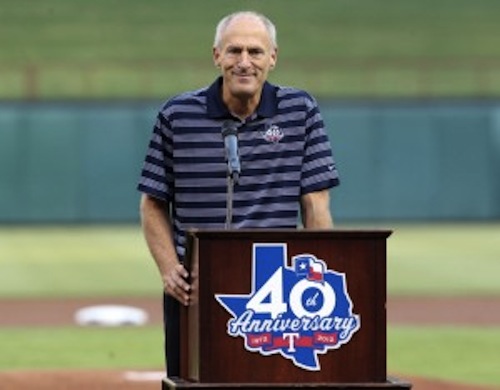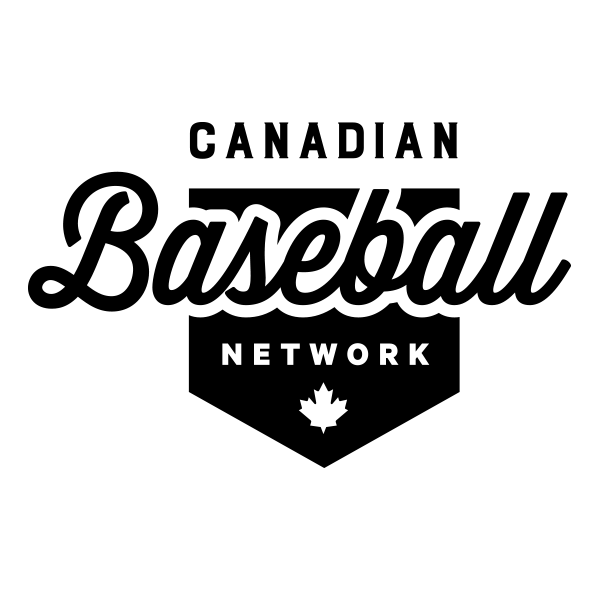Nadel, Coleman, Kubek, Hamilton happy for Cheek
* His broadcasting brethren Eric Nadel, Tom Hamilton, above, along with former Ford C. Frick winners Jerry Coleman and Tony Kubek are happy Tom Cheek has won the Ford C. Frick award. ....
MLB, Brewers open workouts 2014 Canadian draft list 2013 Canadians in the Minors 2013 Canadian collegians playing summer ball 2013 Canadians in College Letters of Intent
Streaker Jarin respected Cheek
“Swing and a Belt,” hip-hop tribute
Brenner won first Cheek invitational
Cheek tribute video wins IDEA honours
Kubek: “You are THE guy”
Tom Cheek: On HOF War Horses Ted Williams, Early Wynn
RationaL: A Swing and a Belt
By Bob Elliott
His first year working for the Texas Rangers, in 1979, broadcaster Eric Nadel walked down the hallway of the Exhibition Stadium press box to introduce himself to Tom Cheek and Early Wynn.
His first year working Cleveland Indians games, Tom Hamilton headed next door to the Blue Jays booth to meet Jerry Howarth and Cheek in 1990, who he found both to be gracious and accommodating.
“I thought it was up to me, I was the rookie,” said Hamilton. “Tom was one of the most influential people in my broadcasting career.”
Ford C. Frick winner Tony Kubek saw the Jays twice a week, Wednesdays and Sundays.
“The first guys I went to see were the radio guys, then beat writers to find out what was going on, they saw the ups and downs of a team,” said Kubek.
Now, Shirley Cheek is three days away from stepping to the podium at Doubleday Field to accept the Ford C. Frick award for her late husband.
“He was a wonderful broadcaster, I met him years ago when I was in Toronto doing CBS radio,” said Jerry Coleman from San Diego, the 2005 Frick winner. “He was an outstanding broadcaster, he deserves it. It’s going to be a great weekend for his family.”
Broadcasting brethren like Coleman, Nadel, Kubek and Hamilton are excited to see Cheek honoured.
“Tom would always wanted to know who was worth talking to with your team,” said Nadel from Dallas. “Tom had an ability to call the dramatic moments.
“He was like my partner, Mark Holtz, a combination of the big voice, a certain presence and a knack for building to the moment.”
Hamilton, who said “Tom made everyone feel like he was their friends,” liked Cheek’s voice so much he took him home with him ... sort of, like he did in every other city his first two years.
He had a combination tape recorder/radio (“if you gave one to a kid nowadays he’d say ‘what’s that?’) and after the Indians pre-game show was over, he’d tune into the local station, click a button and tell Indians fans what was happening.
The next day he’d listen to the other club’s announcers while working out ... as Cheek had learned listening to his tape of Montreal Expos broadcaster Dave Van Horne, driving to Vermont from the Olympic Stadium.
“You listen to some and think ‘ah, I should said that,’ or ‘how the hell did I ever get hired?’ Tom was a broadcaster who made you feel like that,” said Hamilton from Cleveland. “We may think we are all original, but in a lot of ways we are copy cats.
“We find things we like to incorporate. I never wanted to become was a mimic, it was a way to pick up phrases, to compare.”
The biggest lesson Hamilton learned from listening to Cheek?
“His ability to stay calm and make the call,” Hamilton said. “He never got too excited, you have to be comfortable with your style, Tom could make a call at critical time. A lot of guys are overcome by the moment. We sometimes forget our job is to inform the people listening.”
Hamilton said Jays fans were lucky to have Cheek from opening day 1977 until 2005.
“Tom never wanted to leave Toronto, when he could have had any job in baseball, that’s a credit to his loyalty to the franchise and the city,” said Hamilton.
When the Tampa Bay Rays were given an expansion team in 1998 word spread that someone from Toronto had applied for the radio job. Tropicana Field was 23 miles from Cheek’s house at East Lake Woodlands in Oldsmar.
It had to have been Cheek who applied. Golf year round? Except when we found out the name of the Toronto applicant it was a writer.
“Tom told me was if you rehearse a call, it will sound rehearsed, he’d say ‘don’t try to script it, let it come,” the Indians broadcaster said. “At the most critical moment be spontaneous.”
And that’s what Cheek was when Joe Carter went deep and jumped for joy, almost missing first.
“There’s not a better call than the Tom’s call on the home run, including Vin Scully, or Jack Buck on Kirk Gibson’s homer (1988 World Series),” said Hamilton. “We all hope to make a call like that.
“It was a classic, it could have been better had he rehearsed it 100 times.”

How close did Toronto Maple Leafs fans come to knowing the name Eric Nadel?
The Leafs needed someone to run the publicity department in 1976 and Nadel, voice of the Dallas Black Hawks and P.R. director of the Leafs farm team, flew into Toronto for an interview with owner Harold Ballard.
He waited inside the Leafs office at Maple Leaf Gardens as Johnny Bower and Gerry McNamara passed through before being called to Ballard’s apartment.
“He had a big white bear rug and said ‘let me tell you something, I don’t need a P.R. guy, when the New York Yankees come in to town, I’ll do something to make sure we’re the lead story in the papers and not the Blue Jays,’” said Nadel from Dallas. “But my staff and Jim Gregory tell me I need someone.”
Nadel told Ballard he was not sure he wanted to give up broadcasting. Ballard told Nadel if he wanted, he could broadcast the Marlies games -- if he found a network and sponsors.
Nadel went on to become the voice of the Texas Rangers and Gord Stellick was hired, later becoming GM, a job Nadel might have had.
